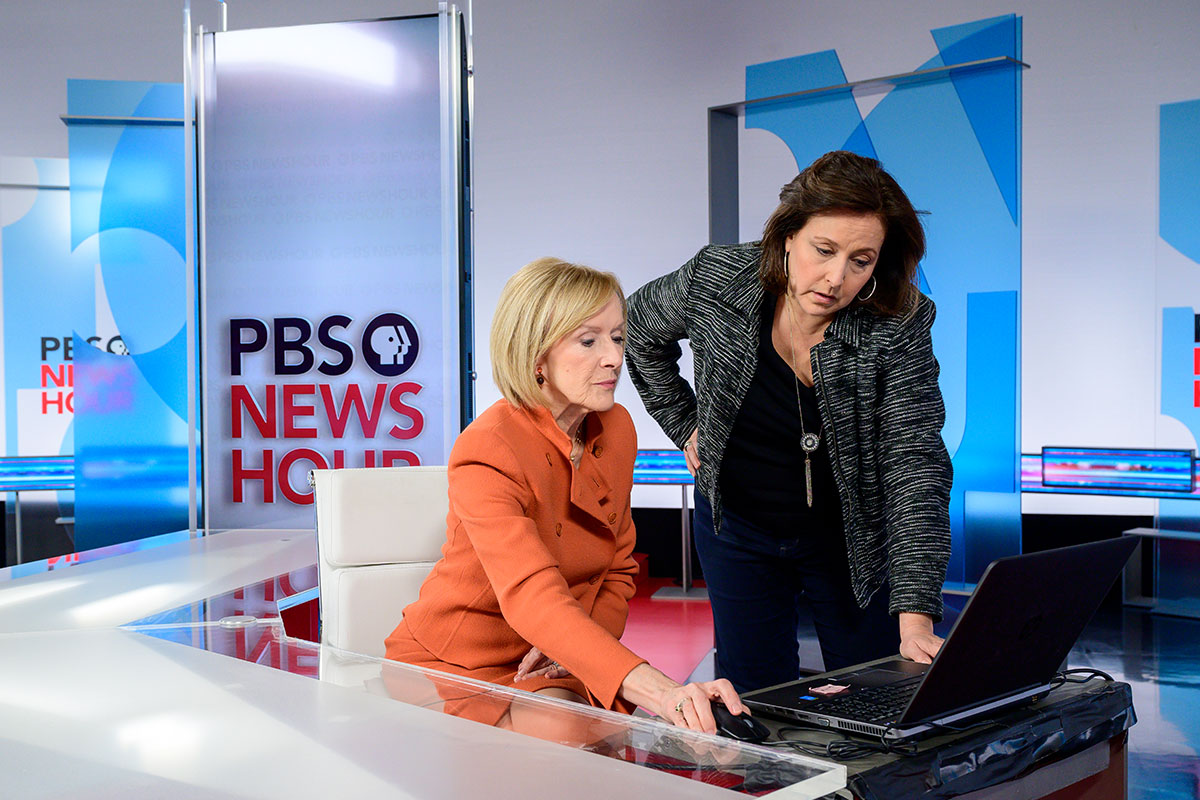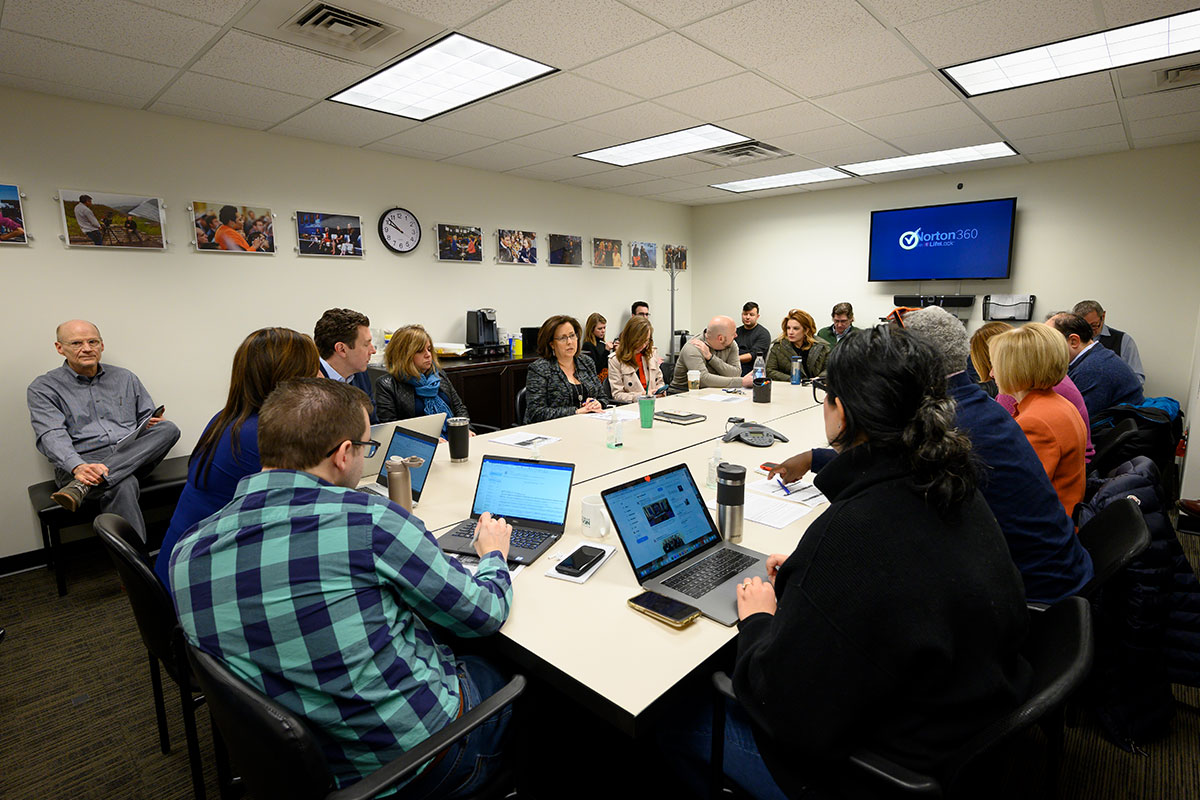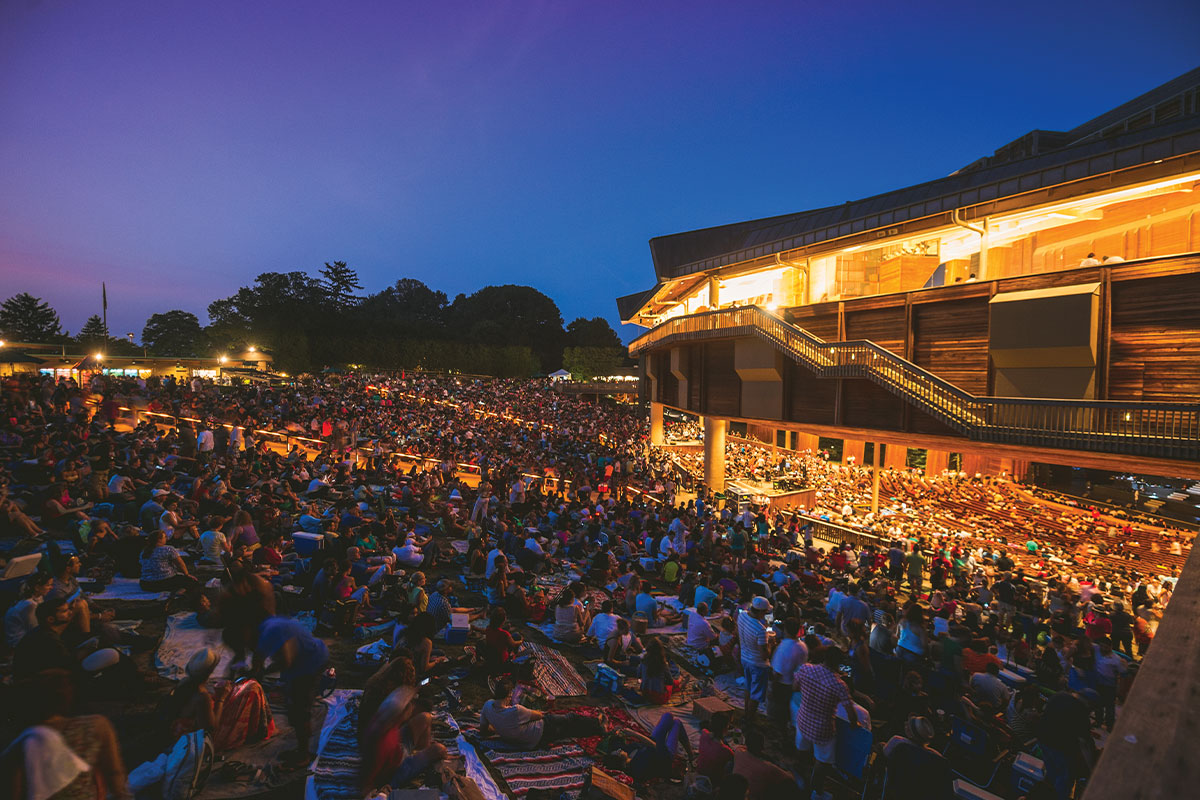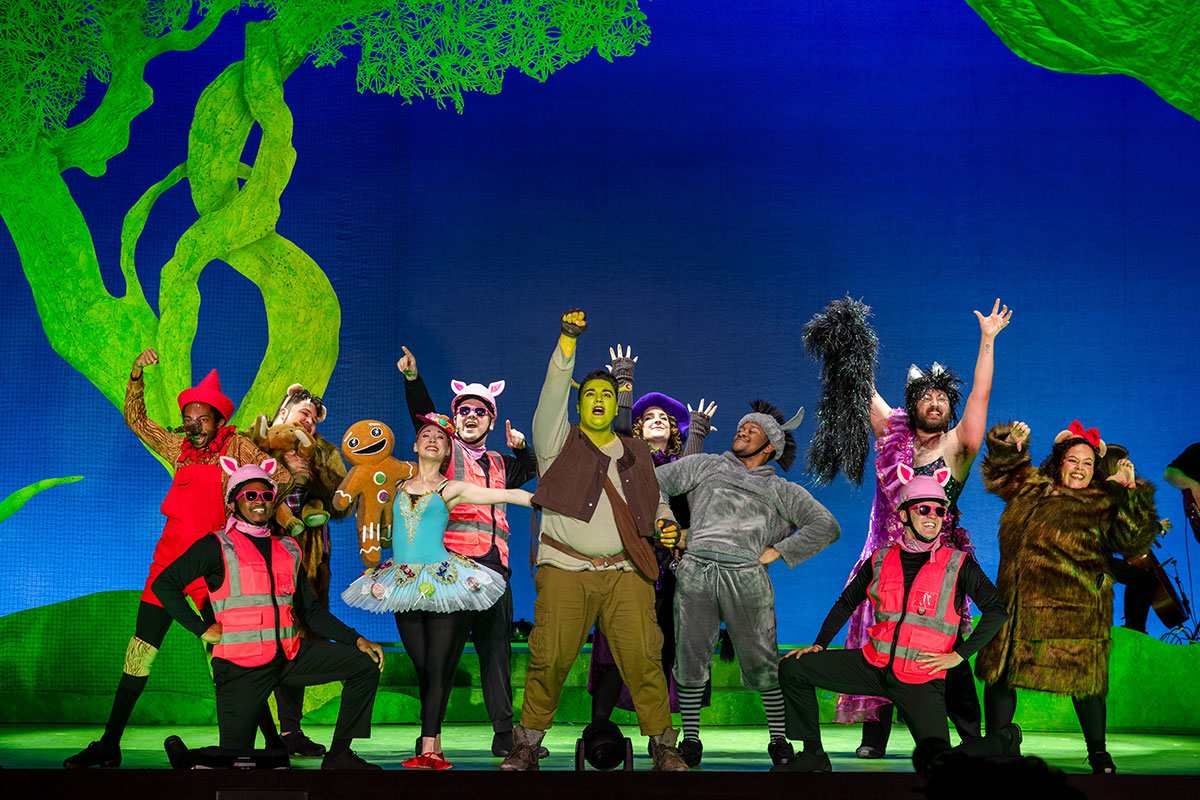Editor’s Note: This story was written pre-pandemic. While PBS NewsHour continues to produce its iconic, long-running news program, much of the staff is now working from home, including anchor Judy Woodruff and the show’s other journalists, who report from their homes each night.
This is how PBS NewsHour happens every weekday: with a 9:45 a.m. meeting that feels, already, like midday.
Each morning, some 30 people fit into a tight conference room in a low-slung brick building on the outskirts of Shirlington to discuss what the longtime public television fixture will air that evening at 6 p.m. Some of the professionally dressed, mixed-aged employees sit at the conference table while others take positions in seats against the wall. Few, if any, throw more than a cursory glance at the flat-screen television on the wall showing CNN on mute.
Sara Just, the deferential alpha leader, gets the conversation going, taking brief oral reports from various department heads and listening to story pitches from reporters and producers. At one point, Just, who is the executive producer of the program, Correspondent Lisa Desjardins and Anchor and Managing Editor Judy Woodruff have a lively discussion about the latest political maneuvering in the White House, with Senior National Correspondent and primary substitute anchor Amna Nawaz eventually weighing in.
The conversation is impressively collaborative—the entire meeting is actually, and punctuated with laughs—with Just having the last word as she finishes making notes in a notebook. “We’ll do it on Tuesday,” she announces. No one seems disappointed.
It’s almost 11 a.m. when Just excuses all but the senior producers and a handful of reporters who stay behind to figure out what order the news pieces will air on tonight’s telecast. Politics leads the way, followed by national and international news—including an interview that will be taped at 4 p.m. with Science Correspondent Miles O’Brien reporting from a burned-out Australian forest—with culture and a smattering of sports rounding things out.

PBS NewsHour is remarkable for a number of reasons, not the least of which is its production facility. While other news organizations wave their banners in neon-illuminated big city towers, PBS NewsHour sends its program to 300 PBS stations a day—covering 98% of the country—from an unassuming, 1960s brick building in Nauck, south of Four Mile Run, and a stone’s throw from the neighborhood’s iconic landmark, the Weenie Beenie half-smoke and barbecue stand.
“When I first came here for a meeting with [program co-founder] Jim Lehrer, the marker he told me was, ‘Turn at the Weenie Beenie,’” says Woodruff. “I said, ‘The what?’ But that’s been the landmark. That’s a very sacred part of the neighborhood.”
If not for the single “WETA” sign over the front door and an oversized satellite dish in the parking lot, the headquarters for one of the longest-running and most influential news programs could be mistaken for any other South Arlington office park. Glamorous it’s not.
But glamour is not what the program aims for, image-wise or otherwise. The unassuming exterior reflects the quiet credo of the content and the famed temperament of the program. In fact, says Woodruff, the show benefits from being removed from the epicenter of “official” Washington, where it’s easy to be consumed by the scope and pace.
“There’s something about the mentality of being just outside Washington—even though I live in the District, and I love living in the District, going back 40 years,” says Woodruff. “But there’s something about having a news organization that’s just outside Washington that clears your mind in a way, and it makes you appreciate that we don’t live just in a city, we live in a really interesting metropolitan area.”
The even-handed tenor has become the trademark of the show.

“I’m a big fan of NewsHour,” says Paul Farhi, the longtime media reporter for The Washington Post. “It’s comprehensive, no-nonsense and as straight down the middle as you can get in this very polarized news environment. Maybe it is the middle, the program that defines the dividing line.”
Besides the gentle tempo and civil delivery, NewsHour is also known for probing news deeper than other networks do, with longer, more fully developed stories. It’s an invaluable service in today’s broadcast news landscape.
“We live in a world of 24-hour information, but that doesn’t mean we live in a world of 24-hour news,” says Farhi. “Programs like NewsHour ignore the flash and the smoke and concentrate on the facts. That’s more important now than ever before when we’re drowning in nonsense. The most important thing you can say about any news source is what I’d say about NewsHour: I trust it.”
Talk with enough of the program’s producers and reporters, and it’s clear there is a force at work on how the show remains a reliable bastion of what Senior Foreign Affairs Producer Morgan Till characterizes as the mission: “Tell people the news, tell them what they need to know with neither fear nor favor, and do it in a sober, analytical fashion.”
It starts at the top with Sara Just.
Sara Just came to PBS NewsHour in 2014 after a surprisingly long career given her age, 54, with television news powerhouses. She spent 17 years helping put together Ted Koppel’s groundbreaking late-night show, Nightline, on ABC. She was ABC’s deputy Washington bureau chief and senior Washington producer for Good Morning America. For six years she helped usher in ABC’s digital politics coverage. At NewsHour, she’s also made digital a priority, which has led to triple-digit growth on all major digital and social platforms since she came on board.
Along the way she raised two sons—Jason is now 22, Benjamin is 17—and has been married to Ray Treacy, a teacher in Fairfax County, for 25 years.
Just’s journalism career began in print, after college at Columbia in New York at the Patriot Ledger in the Boston suburb of Quincy (she’s from Massachusetts). “And I liked it, but when I started in television there was something about it. It fit better, and it was very much a team effort,” she says.
Her team now consists of 100 teammates and growing, particularly in the digital realm. She is also a senior vice president of Arlington’s WETA, the producing station of PBS NewsHour.
For all of her success as a producer—among other accolades, 15 Emmy Awards, six Peabody Awards and three duPont-Columbia Awards—she was never an on-air reporter. “I like being behind the scenes,” she says. “We work with such talented people, and it’s their face that’s out there—they’re telling the story. My job, for a large part, is to make sure they’re comfortable with everything we’re doing. I want them to feel good and shine. I like supporting them and helping them grow.”
“At the core, she’s just a generous, warm person,” says James Blue. Blue is the senior content and special projects producer for the show, “the best job in TV,” he says. While he and Just have been working together on and off since 1994, when they first met they were competition—working the 1993 Branch Davidians siege in Waco, Texas—she at Nightline and he at NBC’s Today show.
“She’s serious and no-nonsense, but the reason why she’s so effective is, she never forgets to ask me about my kids, or my friends outside of work,” Blue says. “It’s just a really great combination of the personal and the professional.”
In 2015, Just recruited Blue to PBS NewsHour to assist with special programming, something he never imagined doing. “But she says, ‘We’re going to change it, and I think it’s something you’re going to enjoy,’” he says.
Wait. What? Change NewsHour? In some circles, that would be broadcast blasphemy. The show is the last survivor of television news’ golden age, having been nurtured at a time when names such as Cronkite, Reasoner, Huntley and Brinkley were the nation’s must-see TV to find out what was going on in the world, without a filter or a slant. Any obvious change would be tantamount to defacing a shrine.
The show has Richard Nixon to thank for its existence. After winning an Emmy for their Watergate coverage, newsmen Robert MacNeil and Jim Lehrer started “The Robert MacNeil Report,” unique in the industry for covering just one story for 30 minutes. In 1976, the show was renamed “The MacNeil/Lehrer Report,” and expanded its coverage, with MacNeil anchoring from WNET-TV in New York and Lehrer anchoring from WETA-TV in Arlington.
In 1983, the show expanded to an unheard of one-hour long and became The MacNeil/Lehrer NewsHour. Woodruff joined the staff that year, recruited from NBC. She was all too happy to make the turn off the road at the Weenie Beenie. “It was just so exciting being at the beginning of an hour-long news program,” Woodruff says.
The conversational format and civil tone solidified, surviving the retirement of MacNeil in 1995 and Lehrer in 2011. Woodruff and Gwen Ifill, who came on board in 1999, were the first all-women anchors of a national news broadcast, sharing the desk starting in 2013 until Ifill passed away just over two years later from cancer in November 2016. (Lehrer died in January.)
“It was the biggest imaginable blow, losing Gwen,” Woodruff says. “We didn’t have any idea that she was going to go; no one thought it was the end. We thought this was something she was going to beat and be back. It was a huge emotional blow. Gwen was a central part of the fabric of this place and had a lot of long-standing relationships—she was just a larger-than-life personality.”
Woodruff glanced out the window before continuing. “She was someone people looked up to and respected; she had deep friendships going back many years. Losing her wasn’t just losing the co-anchor, it was losing somebody who was part of the heart and soul of this place. It left a big opening.”
Just had been at the helm for two years—“We feel Gwen’s loss every day,” she says—and was making the changes promised to Blue and others. But was she going to revamp the set, music and graphics that were so familiar to the loyal audience?
Actually, she did.

“The show has an amazing legacy of history, but we wanted to speed up what I call the ‘metabolism’ a little bit,” Just says. “We changed the set, the music, the graphics. We added more original reporting, and I’m glad we did because the news moves very quickly.”
In addition to ramping up PBS NewsHour West, which updates the show for audiences in western time zones (more than 20% of the viewership is in the Pacific time zone) and stations with later broadcasts, she also emphasized the show’s digital presence, expanding the digital team to 26 dedicated content managers and producers. “It’s a top priority, so that our brand of journalism can be seen wherever people are looking for news,” Just says.
“The civil tone, that’s Sara all the way,” says Senior National Correspondent Amna Nawaz, a graduate of Fairfax County’s Thomas Jefferson High School for Science and Technology. “What Sara’s done for accelerating all our social and digital outlets, some of our biggest traffic coming to the show is coming online. YouTube, Twitter, Instagram. But at the end of the day, we have the benefit of this amazing hour where we can say, ‘All this stuff happened today, here’s what you need to know and understand about it.’ And that is what’s unique about this place.”
Nawaz was a fellow at Nightline when Just was a senior producer in 2001. Just made an impression on the budding journalist. “She was the only female senior producer, I remember noticing that,” Nawaz says. “I don’t know how she did it … All of that experience, because she’s lived through it and navigated it, makes her more understanding when everyone else goes through it.”
And what people go through is more than what happens during office hours, which, by the way, for many of them at NewsHour stretches from that 9:45 a.m. meeting to the end of the telecast at 7 p.m.
“I have two girls, ages 6 and 4, and Sara could not be more understanding” about the time demands of motherhood, Nawaz says.
“I have a young daughter,” says Julia Griffin, senior coordinator of digital video, “and Sara’s a mother, and there are a lot of leaders in this organization that are women and moms, and Sara really understands how complicated it is to be a working mother, and I very much appreciate that.”
Every weeknight, as it has every night for the last four decades, the television control room of the nondescript brick building in Nauck comes to life. Fifteen producers, technicians and graphic artists watch on monitors as Judy Woodruff, at her familiar seat in the nearby studio, tells the nation in a welcoming, measured tone what transpired today that they should know about.
Just sits one seat in from the far left of the control room in a middle row with little to do but admire the work. Joe Camp, who has been at WETA since 1973 and director of NewsHour since 2008, calls the shots and makes sure America sees the unvarnished truth. Fifty-six minutes later, Woodruff signs off, the credits roll and the staff packs up to head out.

And tomorrow, the producers and correspondents will come to the morning meeting with a new set of stories to pitch, having used most of the night and the early morning to find out what they need to tell Just about what needs to be covered.
It’s a long day. Very long. But you would never know it, not in the staff or in the boss. Clearly, Just is inspired by her crew, just as they are by her.
Says Just, “They give me energy every single day.”
This post originally appeared in our August 2020 print issue. For more profiles, subscribe to our newsletters.




